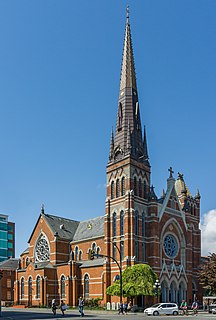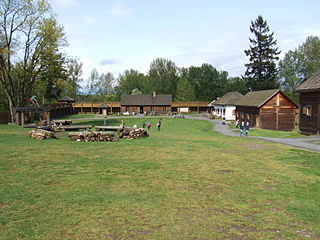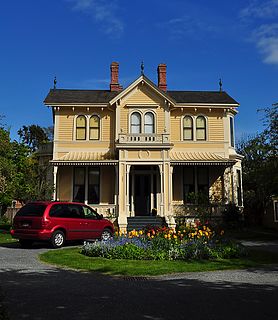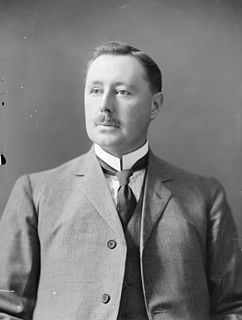
The University of Victoria is a public research university located in the municipalities of Oak Bay and Saanich, British Columbia, Canada. The university traces its roots to Victoria College, the first post-secondary institution established in the province of British Columbia in 1903. It was reincorporated as a university in 1963.

Victoria is the capital city of the Canadian province of British Columbia, on the southern tip of Vancouver Island off Canada's Pacific coast. The city has a population of 85,792, and the Greater Victoria Area has a population of 367,770. Victoria is the 7th most densely populated city in Canada with 4,405.8 inhabitants per square kilometre (11,411/sq mi).

New Westminster is a city in the Lower Mainland region of British Columbia, Canada, and a member municipality of the Metro Vancouver Regional District. It was founded by Major-General Richard Moody as the capital of the new-born Colony of British Columbia in 1858, and continued in that role until the Mainland and Island Colonies were merged in 1866. It was the British Columbia Mainland's largest city from that year until it was passed in population by Vancouver during the first decade of the 20th century.

St. Andrew's Cathedral is the Roman Catholic cathedral for the diocese of Victoria in British Columbia, Canada. Built in the High Victorian Gothic style, St. Andrew's was Victoria's third cathedral to be built.

Klondike Gold Rush National Historical Park is a national historical park operated by the National Park Service that seeks to commemorate the Klondike Gold Rush of the late 1890s. Though the gold fields that were the ultimate goal of the stampeders lay in the Yukon Territory, the park comprises staging areas for the trek there and the routes leading in its direction. There are four units, including three in Municipality of Skagway Borough, Alaska and a fourth in the Pioneer Square National Historic District in Seattle, Washington.

Government House of British Columbia is the official residence of the Lieutenant Governor of British Columbia, as well as that in Victoria of the Canadian monarch, and has casually been described as "the Ceremonial Home of all British Columbians." It stands in the provincial capital on a 14.6 hectares estate at 1401 Rockland Avenue; while the equivalent building in many countries has a prominent, central place in the capital, the site of British Columbia's Government House is relatively unobtrusive within Victoria, giving it more the character of a private home.

The Royal Theatre is a proscenium arch theatre and concert hall located in Victoria, British Columbia, Canada. It was designed in 1912 by William D'Oyly Hamilton Rochfort and Eben W. Sankey. Rochfort was very active as an architect in Victoria from 1908 until he left for the war in 1914. Opened in 1913, the theatre has operated under many guises, including cinema, in 1972 the Municipalities of Oak Bay, Saanich and Victoria purchased the theatre from Famous Players. Since 1982, it has become one of the finest touring destinations in Canada with a fully modernized production department and box office system, while maintaining the grace and style that an early 19th century provides.
The Fairmont Empress, formerly and commonly referred to as The Empress, is one of the oldest hotels in Victoria, British Columbia, Canada. Located on 721 Government Street, it is situated in Downtown Victoria, facing the city's Inner Harbour. The hotel was designed by Francis Rattenbury, and was built by Canadian Pacific Hotels, a division of the Canadian Pacific Railway company. The hotel is presently managed by Fairmont Hotels and Resorts, part of AccorHotels since 2016. It is owned by Nat and Flora Bosa of Vancouver.

Windsor Station is a former railway station in Montreal, Quebec, Canada. It used to be the city's Canadian Pacific Railway (CPR) station, and served as the headquarters of CPR from 1889 to 1996. It is bordered by Avenue des Canadiens-de-Montréal to the north, Peel Street to the east, Saint Antoine Street to the south and the Bell Centre to the west.

Craigdarroch Castle in Victoria, British Columbia, Canada, is a historic, Victorian-era Scottish Baronial mansion. It was designated a National Historic Site of Canada due to its landmark status in Victoria.

Fort Langley National Historic Site, commonly shortened to Fort Langley, is a former fur trading post of the Hudson's Bay Company in the community of Fort Langley of Langley, British Columbia, Canada. The national historic site sits above the banks of the Bedford Channel across McMillan Island. The national historic site contains a visitor centre and a largely reconstructed trading post that contains ten structures surrounded by wooden palisades.

The Chinatown in Victoria, British Columbia is the oldest Chinatown in Canada and the second oldest in North America after San Francisco's. Victoria's Chinatown had its beginnings in the mid-nineteenth century in the mass influx of miners from California to what is now British Columbia in 1858. It remains an actively inhabited place and continues to be popular with residents and visitors, many of whom are Chinese-Canadians. Victoria's Chinatown is now surrounded by cultural, entertainment venues as well as being a venue itself. Chinatown is now conveniently just minutes away from other sites of interests such as the Save-On-Foods Memorial Centre, Bay Centre, Empress Hotel, Market Square, and others.

Mountain View Cemetery is the only cemetery in the City of Vancouver, British Columbia. Opened in 1886, it is located west of Fraser Street between 31st and 43rd Avenues. It is owned and operated by the City of Vancouver and occupies 0.43 square kilometres of land, containing more than 92,000 grave sites and over 145,000 interred remains. The first interment took place on February 26, 1887. The first interment was supposed to happen in January 1887 but poor weather, a new road, and a broken wagon wheel resulted in the intended first occupant being temporarily buried outside the cemetery. His body was relocated to inside the cemetery months later.

Carr House is a National Historic Site of Canada located in Victoria, British Columbia. It was the childhood home of Canadian painter Emily Carr, and had a lasting impression on her paintings and writings.

Downtown Victoria is a neighbourhood of Victoria, British Columbia, Canada that serves as the city centre and the central business district for the City of Victoria, and the Greater Victoria regions.

The Royal Jubilee Hospital is a 500-bed general hospital in Victoria, British Columbia, Canada located about 3 km (1.9 mi) east of the city centre, in the Jubilee neighbourhood.

Edgar Lewis Horwood (1868–1957) was a Canadian architect who served as Chief Dominion Architect from 1915 to 1917.

Victoria City Hall is the city hall for Victoria, British Columbia, Canada. It is located at the corner of Douglas Street and Pandora Avenue adjacent to the CTV Vancouver Island studios and the McPherson Playhouse in downtown Victoria. It is home to the Victoria City Council. It was completed in 1890. It was designated a National Historic Site of Canada in 1977 and was also designated as a heritage site by the municipality in 1979.

The Pemberton Memorial Operating Room is a National Historic Site of Canada, the first operating room of the Royal Jubilee Hospital in Victoria, British Columbia. It established the Royal Jubilee Hospital as the leading surgical hospital in the province.


















